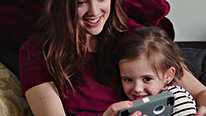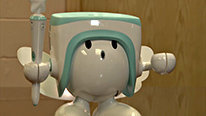- Borgna Brunner
- Editorial Project Director
- Bringing Science Home with PEEP
- http://peepandthebigwideworld.com/en/educators/peep-family-science/
- WGBH
- Megan Silander
- http://cct.edc.org/people/silander-megan
- Research Scientist
- Bringing Science Home with PEEP
- http://peepandthebigwideworld.com/en/educators/peep-family-science/
- Education Development Center (EDC)
Facilitators’
Choice
Choice
Public Discussion
Continue the discussion of this presentation on the Multiplex. Go to Multiplex








Brian Drayton
Co-Director
This looks very interesting! I like the fact that multimodal experiences in this case include interactions with the actual world.
I was intrigued by the mention, in your video, of parents who are not comfortable using media with their kids. I'd like to hear a little more about what the reasons for this discomfort might be?
Borgna Brunner
Editorial Project Director
Thanks for your interest in PEEP!
Some parents who participated in the PEEP study initially worried that using media would distract from rather than enhance their children’s science learning, and some were concerned that their kids might be getting too much screen time already. What parents learned from the PEEP study was that media could in fact be a powerful model for exploring science—as long as it was a shared experience between parent and child. Media can’t substitute for the hands-on science experiences young children get through exploration with actual objects and materials. But it can enrich learning by using animated characters children love to model science practices and spark their curiosity about the world. The trick is to achieve a healthy balance between screen time and real time. To accomplish this, the PEEP app was designed to always introduce a video along with a hands-on activity, which encourages families to transition directly from watching the video to doing a related science activity.
Victor van den Bergh
User Researcher & Evaluator
This looks like a great program. Involving parents in their children's education is critical and you are giving parents a nice set of tools to accomplish that. Peep is a great choice for the cartoon component.
I noticed that all of the parents depicted in your video were mothers. Was that a conscious choice? It made me wonder about whether or not fathers have also participated in the program, and whether or not you noticed any differences in parent outcomes between mothers and fathers.
Thanks for sharing your work!
Megan Silander
Research Scientist
Thanks for your interesting question! Because we partnered with home visiting organizations, we focused on testing the intervention with families already enrolled in their programs--the vast majority of whom are mothers or grandmothers. Because we did not have many fathers participate, we were not able to look at whether outcomes differed by parent gender. It would be interesting to pursue that question in a future study. (Anecdotally, a few mothers told us the activities helped to get their partners more interested in playing with their children.)
Brian Drayton
Co-Director
Hi,
Maybe I missed this detail: Do parents (and kids) get to communicate about their experiences with each other? I could see that being exciting, in different ways, for people within a commnity, and between communities.
Borgna Brunner
Editorial Project Director
I agree! One of the most rewarding aspects of this kind of program would be sharing experiences with other families doing the same science activities. Whether this is possible depends on the model of the home visiting program parents belong to:
Ginger Fitzhugh
Senior Research Associate
Thanks for sharing your interesting work! A few questions for you: for what ages are the activities targeted? How did you evaluate the program? (As an evaluator, I'm always curious how other evaluate their work.) Were your outcomes focused at the individual level (e.g., individual child, individual caregiver) and/or at the family level (e.g., sibling connections, parent-child interactions)?
Megan Silander
Research Scientist
Thank you for your interest in PEEP! The activities are targeted for parents and their four- and five-year old children. To evaluate the program, we used a design-based implementation research (DBIR) design—an iterative and collaborative research and development process that spanned over two years and included multiple pilot studies, culminating in an implementation study. Our outcomes for this study were focused on the parent. Specifically, the implementation study explored how parents’ attitudes and knowledge about helping their young children learn science changed after using the intervention. You can read more about the evaluation here!
Debra Bernstein
I had the same question about the age group - are any of your participants in elementary school, or are they all preschool-aged? (I'm wondering about this partially for personal reasons - I run a Girl Scout troop of kindergarteners and 1st graders, and wonder if you'd recommend the activities for this age group). Thanks.
Borgna Brunner
Editorial Project Director
PEEP activities are designed for preschoolers, but there are definitely a number of activities that would appeal to your Kindergarten and first grade Girl Scouts. But instead of using the PEEP Family Science apps, which are meant for a parent and child, I’d suggest selecting activities from the PEEP Science Curriculum on our website, which are meant for group activities. Thanks for writing!
Debra Bernstein
Thank you!
Colleen Bostwick
I have used PEEP as a science resource for years when developing curriculum. This is a great resource I will be passing along to the parents of my classroom. Do you need to have internet to access the content of the app?
Borgna Brunner
Editorial Project Director
We're very pleased to hear you've been using PEEP in the classroom and that you'll be sharing the PEEP Family Science apps with parents!
Parents will need the Internet to download the app. But once downloaded, the app works completely offline: they won’t need to use their phone’s data plan or the Internet again.
Each app features hands-on activity instructions plus 6 or 7 videos--PEEP animations and two parent videos that model the science activities.
We designed the app to be used offline because the majority of families who belong to the home visiting organizations we worked with did not have reliable Internet.
Michael Rosenfeld
This looks like a fun and effective way to build on the television program and teach basic science skills in an engaging way. I was struck by how much fun both moms and children seemed to be having. Have you studied whether participating in these activities makes kids better prepared once they are in school and engaged in more formal sterm learning?
Megan Silander
Research Scientist
Because this was the first study we conducted, we decided to focus first on how parent attitudes and knowledge changed after using PEEP Family Science. In future studies we would love to explore how the intervention supports children's development, particularly related to school readiness.
Catherine Haden
This is such a great project! And it would be terrific to study how these informal experiences with parents support children's readiness and the intersection between informal and formal STEM learning opportunities.
Seems like the parents reflections on the experience would be a rich source of data for understanding what changes they saw in their children's interest and understanding, as well as their own. Did to elicit parents' reflections? If so, what did they reveal?
Megan Silander
Research Scientist
Yes - we did talk to parents about their perceptions of what their children got out of the experience. Almost all parents talked about different science concepts that they thought their children learned related to the topics of focus in the apps they were learning (e.g. when you tilt a ramp more, it goes faster, and tilting it less makes it go slower). Some parents also talked about new vocabulary that their children learned, or that science can be fun, and others told us about how using the apps and doing the activities helped them spend important one-on-one time together and feel more connected. Here are a few parent/grandparent comments, just to illustrate:
“What do I think? I think that it teaches kids so they learn what quiet means, or high, soft, etcetera. So they’ll learn to differentiate and realize that they’re not all... That they sound different, and know what makes the sounds different... that they learn."
"I mean, because just the other day we were out there with the swing set and all that and [my son] told his sister, he said, Sissy, go down the higher slide, you go faster. So I mean, he picked that up."
"I get to feel like a kid again. I get to enjoy my grandbaby and watch the smile on his face. That right there means more than anything is just seeing him happy. And know that he’s learning."
Laura Peticolas
Thank you for your excellent program. My kids and I loved playing your educational games many years ago. Today, I enjoyed your video as a professional science educator. Keep up the great work!
Borgna Brunner
Editorial Project Director
That's great to hear, Laura! Thanks for writing and letting us know.
Further posting is closed as the showcase has ended.